Organisational Behaviour Report: 1Spatial, Culture, Motivation, Teams
VerifiedAdded on 2020/10/04
|15
|4491
|358
Report
AI Summary
This report examines organisational behaviour within the context of 1Spatial, a geospatial data and 3D software company. The report begins by analyzing the influence of culture, politics, and power, using Handy's typology of culture and exploring different types of power (legitimate, reward, coercive, expert, referent). It then evaluates content and process theories of motivation, specifically Vroom's expectancy theory and Maslow's hierarchy of needs, and how these theories and motivational techniques can enable the achievement of organisational goals. The report further investigates the characteristics of effective and ineffective teams. Finally, it applies concepts and philosophies of organisational behaviour to the 1Spatial context, offering insights into how to foster a positive and productive work environment.
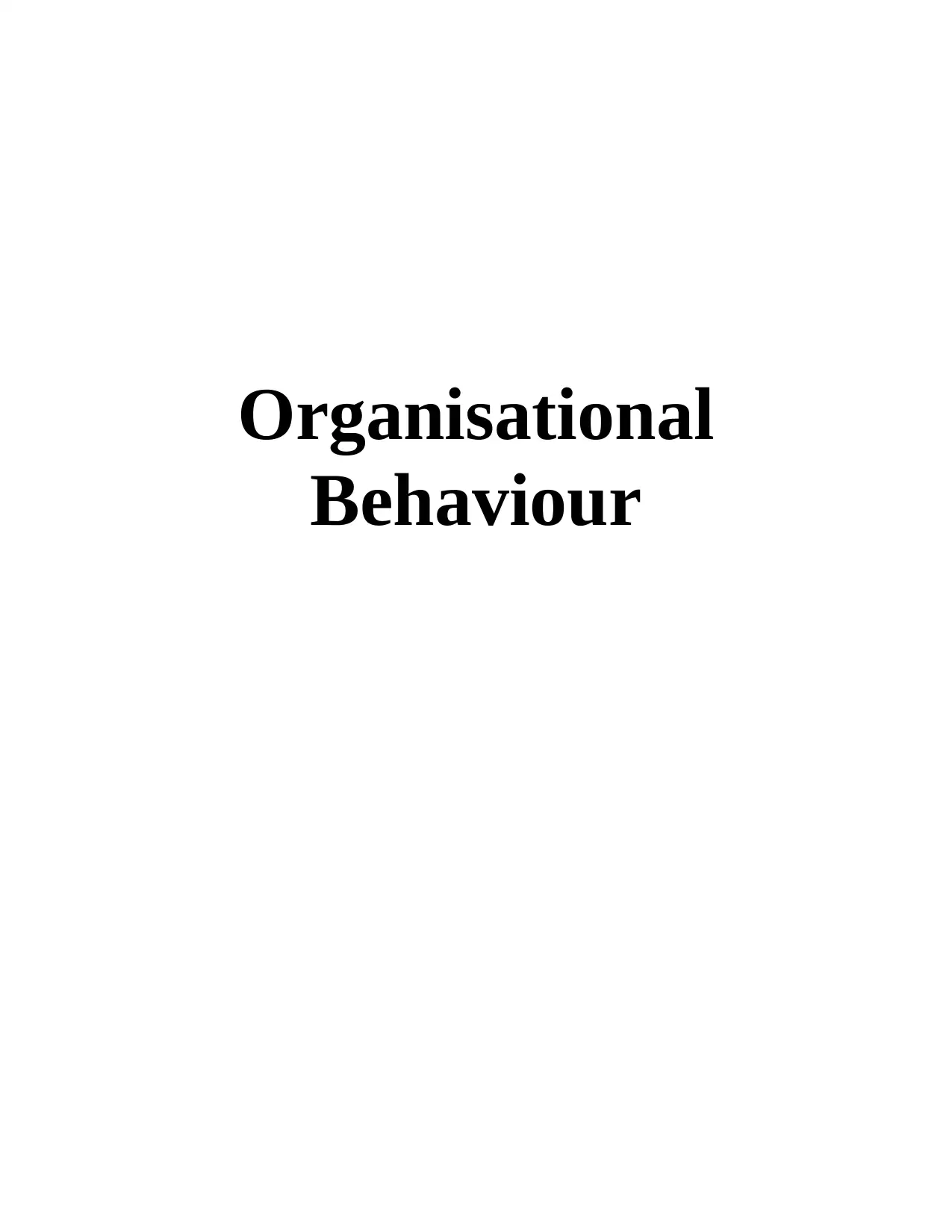
Organisational
Behaviour
Behaviour
Paraphrase This Document
Need a fresh take? Get an instant paraphrase of this document with our AI Paraphraser
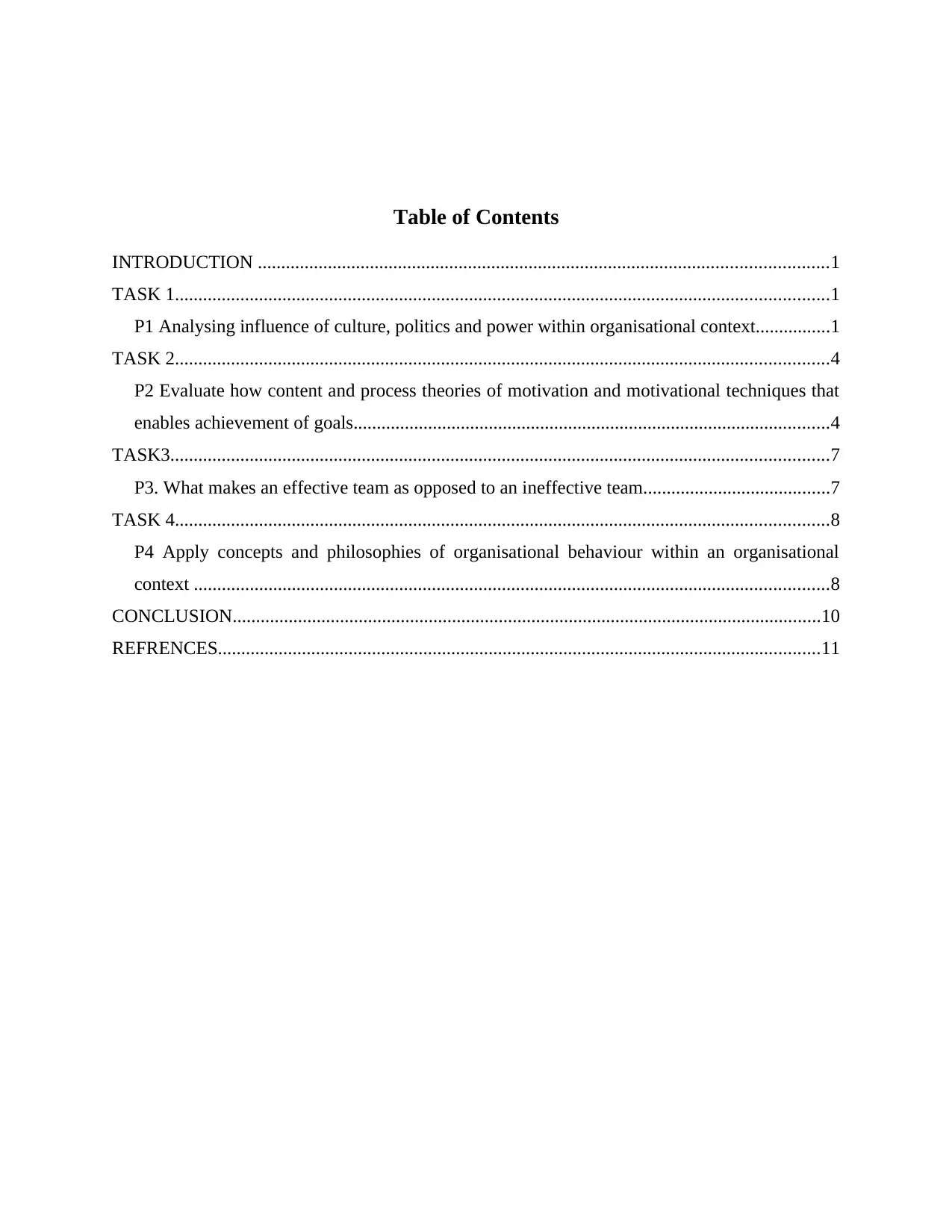
Table of Contents
INTRODUCTION ..........................................................................................................................1
TASK 1............................................................................................................................................1
P1 Analysing influence of culture, politics and power within organisational context................1
TASK 2............................................................................................................................................4
P2 Evaluate how content and process theories of motivation and motivational techniques that
enables achievement of goals......................................................................................................4
TASK3.............................................................................................................................................7
P3. What makes an effective team as opposed to an ineffective team........................................7
TASK 4............................................................................................................................................8
P4 Apply concepts and philosophies of organisational behaviour within an organisational
context ........................................................................................................................................8
CONCLUSION..............................................................................................................................10
REFRENCES.................................................................................................................................11
INTRODUCTION ..........................................................................................................................1
TASK 1............................................................................................................................................1
P1 Analysing influence of culture, politics and power within organisational context................1
TASK 2............................................................................................................................................4
P2 Evaluate how content and process theories of motivation and motivational techniques that
enables achievement of goals......................................................................................................4
TASK3.............................................................................................................................................7
P3. What makes an effective team as opposed to an ineffective team........................................7
TASK 4............................................................................................................................................8
P4 Apply concepts and philosophies of organisational behaviour within an organisational
context ........................................................................................................................................8
CONCLUSION..............................................................................................................................10
REFRENCES.................................................................................................................................11
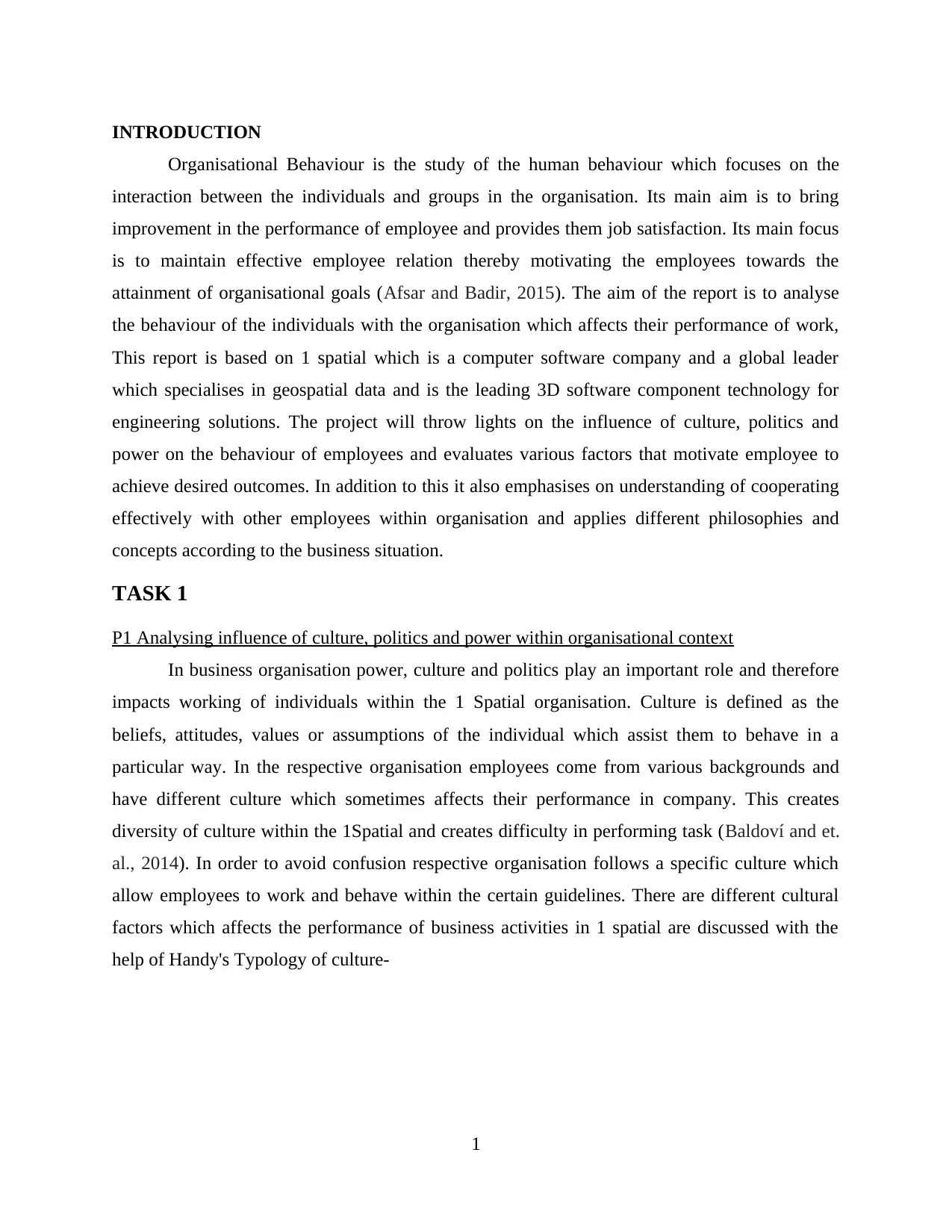
INTRODUCTION
Organisational Behaviour is the study of the human behaviour which focuses on the
interaction between the individuals and groups in the organisation. Its main aim is to bring
improvement in the performance of employee and provides them job satisfaction. Its main focus
is to maintain effective employee relation thereby motivating the employees towards the
attainment of organisational goals (Afsar and Badir, 2015). The aim of the report is to analyse
the behaviour of the individuals with the organisation which affects their performance of work,
This report is based on 1 spatial which is a computer software company and a global leader
which specialises in geospatial data and is the leading 3D software component technology for
engineering solutions. The project will throw lights on the influence of culture, politics and
power on the behaviour of employees and evaluates various factors that motivate employee to
achieve desired outcomes. In addition to this it also emphasises on understanding of cooperating
effectively with other employees within organisation and applies different philosophies and
concepts according to the business situation.
TASK 1
P1 Analysing influence of culture, politics and power within organisational context
In business organisation power, culture and politics play an important role and therefore
impacts working of individuals within the 1 Spatial organisation. Culture is defined as the
beliefs, attitudes, values or assumptions of the individual which assist them to behave in a
particular way. In the respective organisation employees come from various backgrounds and
have different culture which sometimes affects their performance in company. This creates
diversity of culture within the 1Spatial and creates difficulty in performing task (Baldoví and et.
al., 2014). In order to avoid confusion respective organisation follows a specific culture which
allow employees to work and behave within the certain guidelines. There are different cultural
factors which affects the performance of business activities in 1 spatial are discussed with the
help of Handy's Typology of culture-
1
Organisational Behaviour is the study of the human behaviour which focuses on the
interaction between the individuals and groups in the organisation. Its main aim is to bring
improvement in the performance of employee and provides them job satisfaction. Its main focus
is to maintain effective employee relation thereby motivating the employees towards the
attainment of organisational goals (Afsar and Badir, 2015). The aim of the report is to analyse
the behaviour of the individuals with the organisation which affects their performance of work,
This report is based on 1 spatial which is a computer software company and a global leader
which specialises in geospatial data and is the leading 3D software component technology for
engineering solutions. The project will throw lights on the influence of culture, politics and
power on the behaviour of employees and evaluates various factors that motivate employee to
achieve desired outcomes. In addition to this it also emphasises on understanding of cooperating
effectively with other employees within organisation and applies different philosophies and
concepts according to the business situation.
TASK 1
P1 Analysing influence of culture, politics and power within organisational context
In business organisation power, culture and politics play an important role and therefore
impacts working of individuals within the 1 Spatial organisation. Culture is defined as the
beliefs, attitudes, values or assumptions of the individual which assist them to behave in a
particular way. In the respective organisation employees come from various backgrounds and
have different culture which sometimes affects their performance in company. This creates
diversity of culture within the 1Spatial and creates difficulty in performing task (Baldoví and et.
al., 2014). In order to avoid confusion respective organisation follows a specific culture which
allow employees to work and behave within the certain guidelines. There are different cultural
factors which affects the performance of business activities in 1 spatial are discussed with the
help of Handy's Typology of culture-
1
⊘ This is a preview!⊘
Do you want full access?
Subscribe today to unlock all pages.

Trusted by 1+ million students worldwide
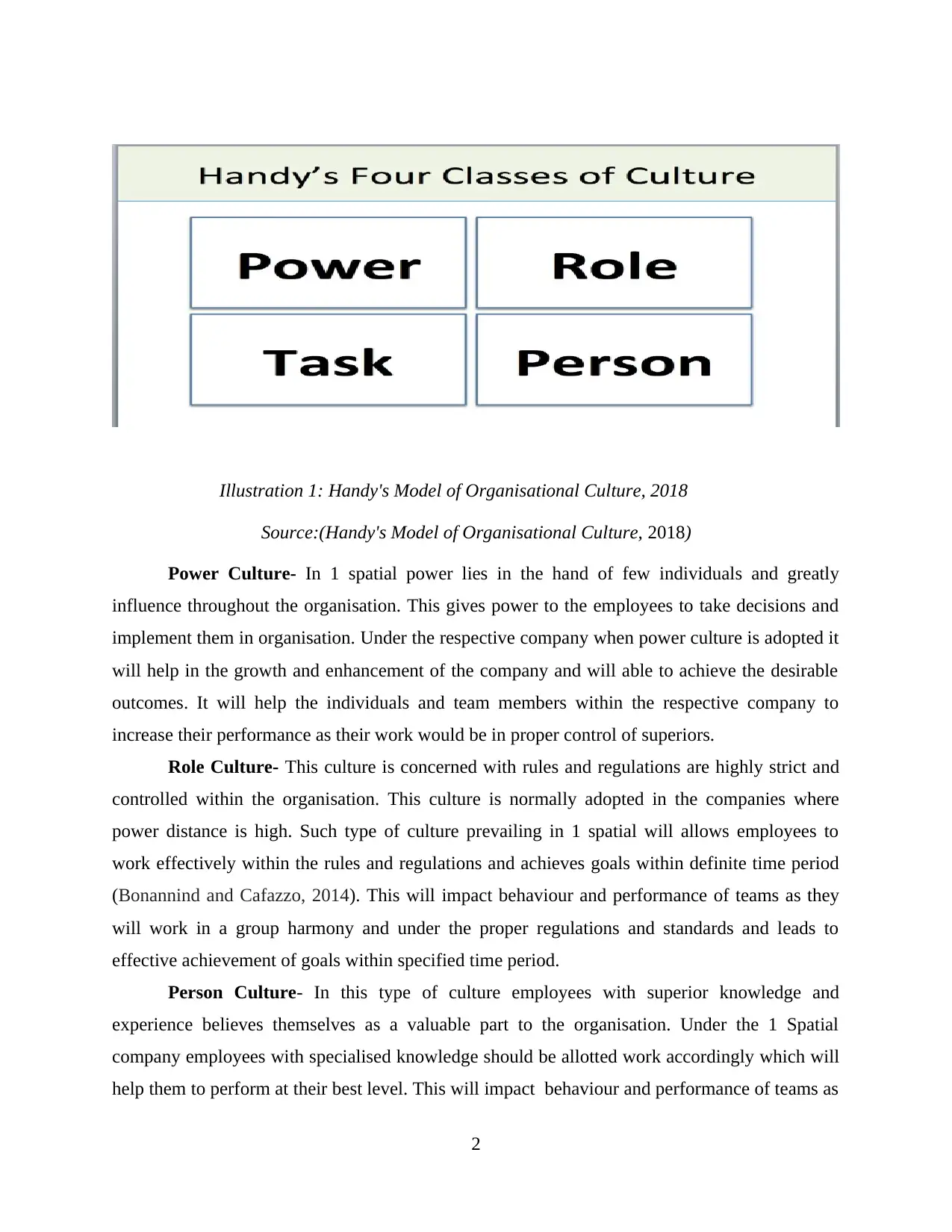
Illustration 1: Handy's Model of Organisational Culture, 2018
Source:(Handy's Model of Organisational Culture, 2018)
Power Culture- In 1 spatial power lies in the hand of few individuals and greatly
influence throughout the organisation. This gives power to the employees to take decisions and
implement them in organisation. Under the respective company when power culture is adopted it
will help in the growth and enhancement of the company and will able to achieve the desirable
outcomes. It will help the individuals and team members within the respective company to
increase their performance as their work would be in proper control of superiors.
Role Culture- This culture is concerned with rules and regulations are highly strict and
controlled within the organisation. This culture is normally adopted in the companies where
power distance is high. Such type of culture prevailing in 1 spatial will allows employees to
work effectively within the rules and regulations and achieves goals within definite time period
(Bonannind and Cafazzo, 2014). This will impact behaviour and performance of teams as they
will work in a group harmony and under the proper regulations and standards and leads to
effective achievement of goals within specified time period.
Person Culture- In this type of culture employees with superior knowledge and
experience believes themselves as a valuable part to the organisation. Under the 1 Spatial
company employees with specialised knowledge should be allotted work accordingly which will
help them to perform at their best level. This will impact behaviour and performance of teams as
2
Source:(Handy's Model of Organisational Culture, 2018)
Power Culture- In 1 spatial power lies in the hand of few individuals and greatly
influence throughout the organisation. This gives power to the employees to take decisions and
implement them in organisation. Under the respective company when power culture is adopted it
will help in the growth and enhancement of the company and will able to achieve the desirable
outcomes. It will help the individuals and team members within the respective company to
increase their performance as their work would be in proper control of superiors.
Role Culture- This culture is concerned with rules and regulations are highly strict and
controlled within the organisation. This culture is normally adopted in the companies where
power distance is high. Such type of culture prevailing in 1 spatial will allows employees to
work effectively within the rules and regulations and achieves goals within definite time period
(Bonannind and Cafazzo, 2014). This will impact behaviour and performance of teams as they
will work in a group harmony and under the proper regulations and standards and leads to
effective achievement of goals within specified time period.
Person Culture- In this type of culture employees with superior knowledge and
experience believes themselves as a valuable part to the organisation. Under the 1 Spatial
company employees with specialised knowledge should be allotted work accordingly which will
help them to perform at their best level. This will impact behaviour and performance of teams as
2
Paraphrase This Document
Need a fresh take? Get an instant paraphrase of this document with our AI Paraphraser
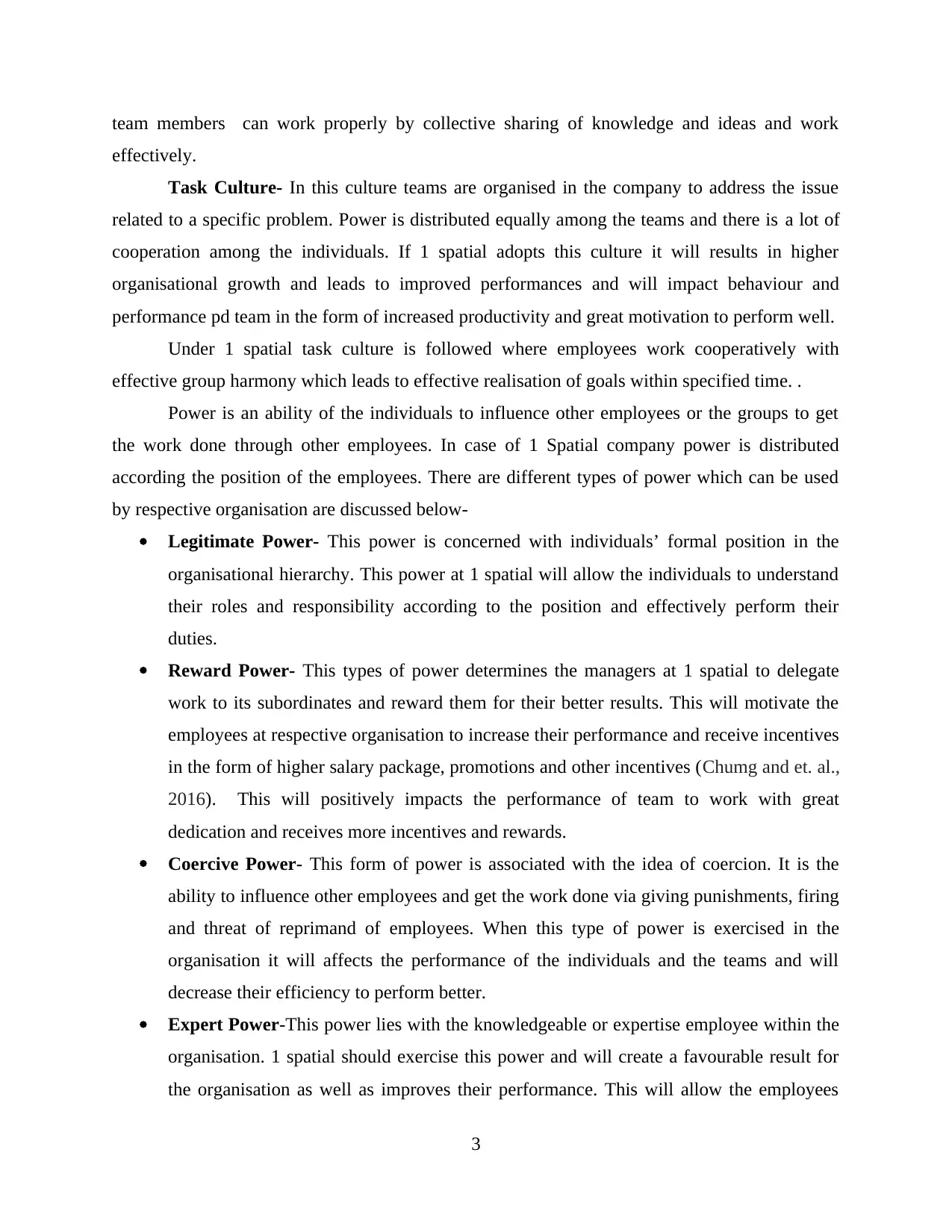
team members can work properly by collective sharing of knowledge and ideas and work
effectively.
Task Culture- In this culture teams are organised in the company to address the issue
related to a specific problem. Power is distributed equally among the teams and there is a lot of
cooperation among the individuals. If 1 spatial adopts this culture it will results in higher
organisational growth and leads to improved performances and will impact behaviour and
performance pd team in the form of increased productivity and great motivation to perform well.
Under 1 spatial task culture is followed where employees work cooperatively with
effective group harmony which leads to effective realisation of goals within specified time. .
Power is an ability of the individuals to influence other employees or the groups to get
the work done through other employees. In case of 1 Spatial company power is distributed
according the position of the employees. There are different types of power which can be used
by respective organisation are discussed below-
Legitimate Power- This power is concerned with individuals’ formal position in the
organisational hierarchy. This power at 1 spatial will allow the individuals to understand
their roles and responsibility according to the position and effectively perform their
duties.
Reward Power- This types of power determines the managers at 1 spatial to delegate
work to its subordinates and reward them for their better results. This will motivate the
employees at respective organisation to increase their performance and receive incentives
in the form of higher salary package, promotions and other incentives (Chumg and et. al.,
2016). This will positively impacts the performance of team to work with great
dedication and receives more incentives and rewards.
Coercive Power- This form of power is associated with the idea of coercion. It is the
ability to influence other employees and get the work done via giving punishments, firing
and threat of reprimand of employees. When this type of power is exercised in the
organisation it will affects the performance of the individuals and the teams and will
decrease their efficiency to perform better.
Expert Power-This power lies with the knowledgeable or expertise employee within the
organisation. 1 spatial should exercise this power and will create a favourable result for
the organisation as well as improves their performance. This will allow the employees
3
effectively.
Task Culture- In this culture teams are organised in the company to address the issue
related to a specific problem. Power is distributed equally among the teams and there is a lot of
cooperation among the individuals. If 1 spatial adopts this culture it will results in higher
organisational growth and leads to improved performances and will impact behaviour and
performance pd team in the form of increased productivity and great motivation to perform well.
Under 1 spatial task culture is followed where employees work cooperatively with
effective group harmony which leads to effective realisation of goals within specified time. .
Power is an ability of the individuals to influence other employees or the groups to get
the work done through other employees. In case of 1 Spatial company power is distributed
according the position of the employees. There are different types of power which can be used
by respective organisation are discussed below-
Legitimate Power- This power is concerned with individuals’ formal position in the
organisational hierarchy. This power at 1 spatial will allow the individuals to understand
their roles and responsibility according to the position and effectively perform their
duties.
Reward Power- This types of power determines the managers at 1 spatial to delegate
work to its subordinates and reward them for their better results. This will motivate the
employees at respective organisation to increase their performance and receive incentives
in the form of higher salary package, promotions and other incentives (Chumg and et. al.,
2016). This will positively impacts the performance of team to work with great
dedication and receives more incentives and rewards.
Coercive Power- This form of power is associated with the idea of coercion. It is the
ability to influence other employees and get the work done via giving punishments, firing
and threat of reprimand of employees. When this type of power is exercised in the
organisation it will affects the performance of the individuals and the teams and will
decrease their efficiency to perform better.
Expert Power-This power lies with the knowledgeable or expertise employee within the
organisation. 1 spatial should exercise this power and will create a favourable result for
the organisation as well as improves their performance. This will allow the employees
3
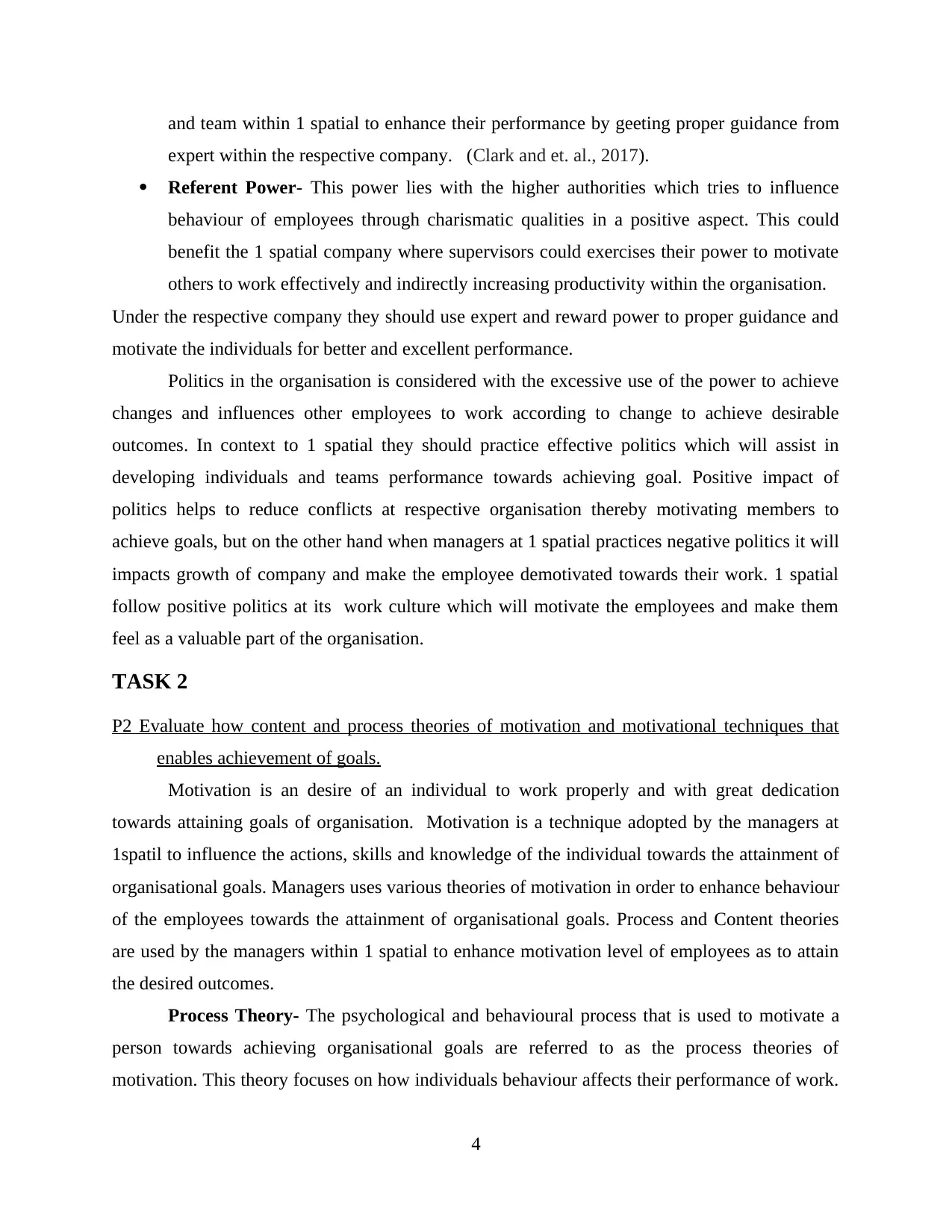
and team within 1 spatial to enhance their performance by geeting proper guidance from
expert within the respective company. (Clark and et. al., 2017).
Referent Power- This power lies with the higher authorities which tries to influence
behaviour of employees through charismatic qualities in a positive aspect. This could
benefit the 1 spatial company where supervisors could exercises their power to motivate
others to work effectively and indirectly increasing productivity within the organisation.
Under the respective company they should use expert and reward power to proper guidance and
motivate the individuals for better and excellent performance.
Politics in the organisation is considered with the excessive use of the power to achieve
changes and influences other employees to work according to change to achieve desirable
outcomes. In context to 1 spatial they should practice effective politics which will assist in
developing individuals and teams performance towards achieving goal. Positive impact of
politics helps to reduce conflicts at respective organisation thereby motivating members to
achieve goals, but on the other hand when managers at 1 spatial practices negative politics it will
impacts growth of company and make the employee demotivated towards their work. 1 spatial
follow positive politics at its work culture which will motivate the employees and make them
feel as a valuable part of the organisation.
TASK 2
P2 Evaluate how content and process theories of motivation and motivational techniques that
enables achievement of goals.
Motivation is an desire of an individual to work properly and with great dedication
towards attaining goals of organisation. Motivation is a technique adopted by the managers at
1spatil to influence the actions, skills and knowledge of the individual towards the attainment of
organisational goals. Managers uses various theories of motivation in order to enhance behaviour
of the employees towards the attainment of organisational goals. Process and Content theories
are used by the managers within 1 spatial to enhance motivation level of employees as to attain
the desired outcomes.
Process Theory- The psychological and behavioural process that is used to motivate a
person towards achieving organisational goals are referred to as the process theories of
motivation. This theory focuses on how individuals behaviour affects their performance of work.
4
expert within the respective company. (Clark and et. al., 2017).
Referent Power- This power lies with the higher authorities which tries to influence
behaviour of employees through charismatic qualities in a positive aspect. This could
benefit the 1 spatial company where supervisors could exercises their power to motivate
others to work effectively and indirectly increasing productivity within the organisation.
Under the respective company they should use expert and reward power to proper guidance and
motivate the individuals for better and excellent performance.
Politics in the organisation is considered with the excessive use of the power to achieve
changes and influences other employees to work according to change to achieve desirable
outcomes. In context to 1 spatial they should practice effective politics which will assist in
developing individuals and teams performance towards achieving goal. Positive impact of
politics helps to reduce conflicts at respective organisation thereby motivating members to
achieve goals, but on the other hand when managers at 1 spatial practices negative politics it will
impacts growth of company and make the employee demotivated towards their work. 1 spatial
follow positive politics at its work culture which will motivate the employees and make them
feel as a valuable part of the organisation.
TASK 2
P2 Evaluate how content and process theories of motivation and motivational techniques that
enables achievement of goals.
Motivation is an desire of an individual to work properly and with great dedication
towards attaining goals of organisation. Motivation is a technique adopted by the managers at
1spatil to influence the actions, skills and knowledge of the individual towards the attainment of
organisational goals. Managers uses various theories of motivation in order to enhance behaviour
of the employees towards the attainment of organisational goals. Process and Content theories
are used by the managers within 1 spatial to enhance motivation level of employees as to attain
the desired outcomes.
Process Theory- The psychological and behavioural process that is used to motivate a
person towards achieving organisational goals are referred to as the process theories of
motivation. This theory focuses on how individuals behaviour affects their performance of work.
4
⊘ This is a preview!⊘
Do you want full access?
Subscribe today to unlock all pages.

Trusted by 1+ million students worldwide
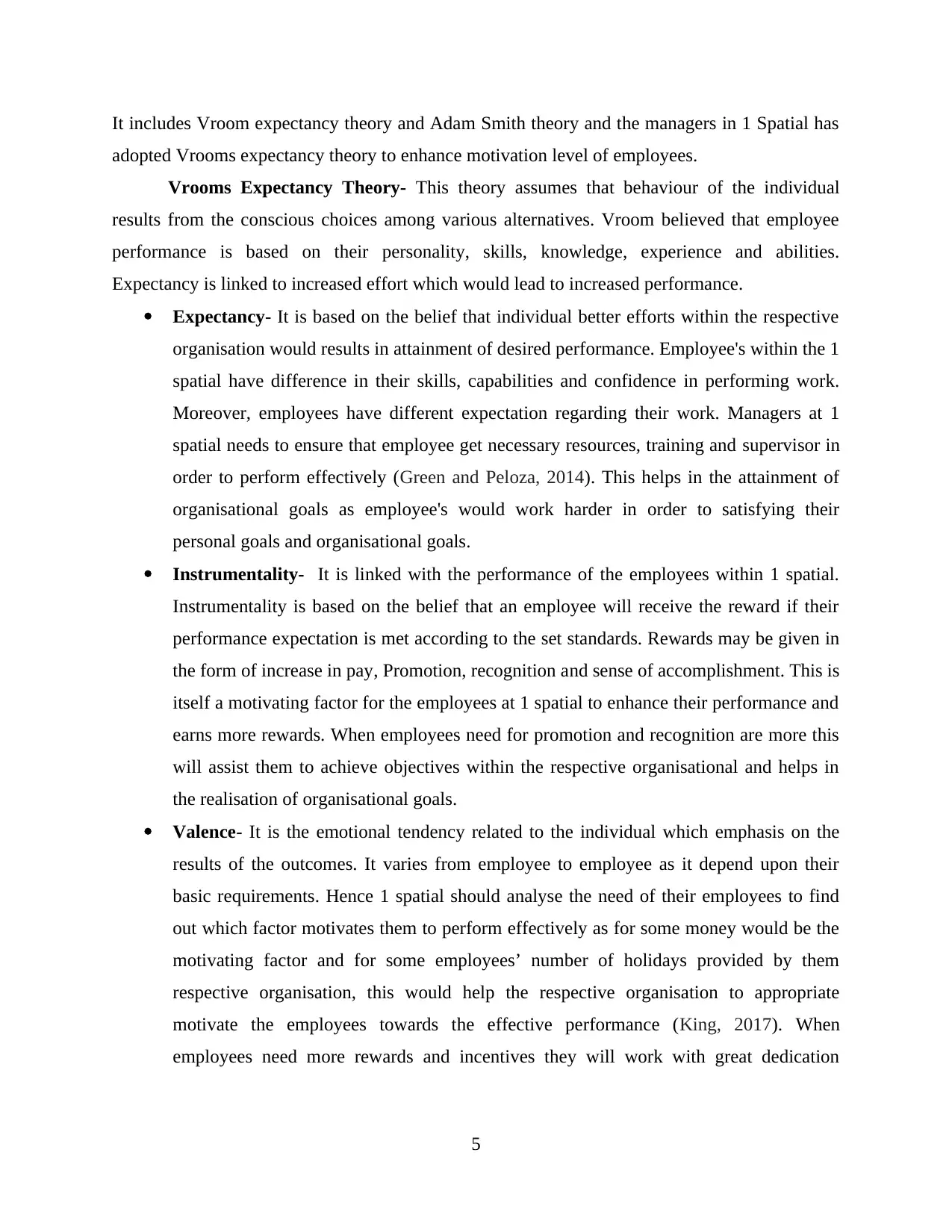
It includes Vroom expectancy theory and Adam Smith theory and the managers in 1 Spatial has
adopted Vrooms expectancy theory to enhance motivation level of employees.
Vrooms Expectancy Theory- This theory assumes that behaviour of the individual
results from the conscious choices among various alternatives. Vroom believed that employee
performance is based on their personality, skills, knowledge, experience and abilities.
Expectancy is linked to increased effort which would lead to increased performance.
Expectancy- It is based on the belief that individual better efforts within the respective
organisation would results in attainment of desired performance. Employee's within the 1
spatial have difference in their skills, capabilities and confidence in performing work.
Moreover, employees have different expectation regarding their work. Managers at 1
spatial needs to ensure that employee get necessary resources, training and supervisor in
order to perform effectively (Green and Peloza, 2014). This helps in the attainment of
organisational goals as employee's would work harder in order to satisfying their
personal goals and organisational goals.
Instrumentality- It is linked with the performance of the employees within 1 spatial.
Instrumentality is based on the belief that an employee will receive the reward if their
performance expectation is met according to the set standards. Rewards may be given in
the form of increase in pay, Promotion, recognition and sense of accomplishment. This is
itself a motivating factor for the employees at 1 spatial to enhance their performance and
earns more rewards. When employees need for promotion and recognition are more this
will assist them to achieve objectives within the respective organisational and helps in
the realisation of organisational goals.
Valence- It is the emotional tendency related to the individual which emphasis on the
results of the outcomes. It varies from employee to employee as it depend upon their
basic requirements. Hence 1 spatial should analyse the need of their employees to find
out which factor motivates them to perform effectively as for some money would be the
motivating factor and for some employees’ number of holidays provided by them
respective organisation, this would help the respective organisation to appropriate
motivate the employees towards the effective performance (King, 2017). When
employees need more rewards and incentives they will work with great dedication
5
adopted Vrooms expectancy theory to enhance motivation level of employees.
Vrooms Expectancy Theory- This theory assumes that behaviour of the individual
results from the conscious choices among various alternatives. Vroom believed that employee
performance is based on their personality, skills, knowledge, experience and abilities.
Expectancy is linked to increased effort which would lead to increased performance.
Expectancy- It is based on the belief that individual better efforts within the respective
organisation would results in attainment of desired performance. Employee's within the 1
spatial have difference in their skills, capabilities and confidence in performing work.
Moreover, employees have different expectation regarding their work. Managers at 1
spatial needs to ensure that employee get necessary resources, training and supervisor in
order to perform effectively (Green and Peloza, 2014). This helps in the attainment of
organisational goals as employee's would work harder in order to satisfying their
personal goals and organisational goals.
Instrumentality- It is linked with the performance of the employees within 1 spatial.
Instrumentality is based on the belief that an employee will receive the reward if their
performance expectation is met according to the set standards. Rewards may be given in
the form of increase in pay, Promotion, recognition and sense of accomplishment. This is
itself a motivating factor for the employees at 1 spatial to enhance their performance and
earns more rewards. When employees need for promotion and recognition are more this
will assist them to achieve objectives within the respective organisational and helps in
the realisation of organisational goals.
Valence- It is the emotional tendency related to the individual which emphasis on the
results of the outcomes. It varies from employee to employee as it depend upon their
basic requirements. Hence 1 spatial should analyse the need of their employees to find
out which factor motivates them to perform effectively as for some money would be the
motivating factor and for some employees’ number of holidays provided by them
respective organisation, this would help the respective organisation to appropriate
motivate the employees towards the effective performance (King, 2017). When
employees need more rewards and incentives they will work with great dedication
5
Paraphrase This Document
Need a fresh take? Get an instant paraphrase of this document with our AI Paraphraser
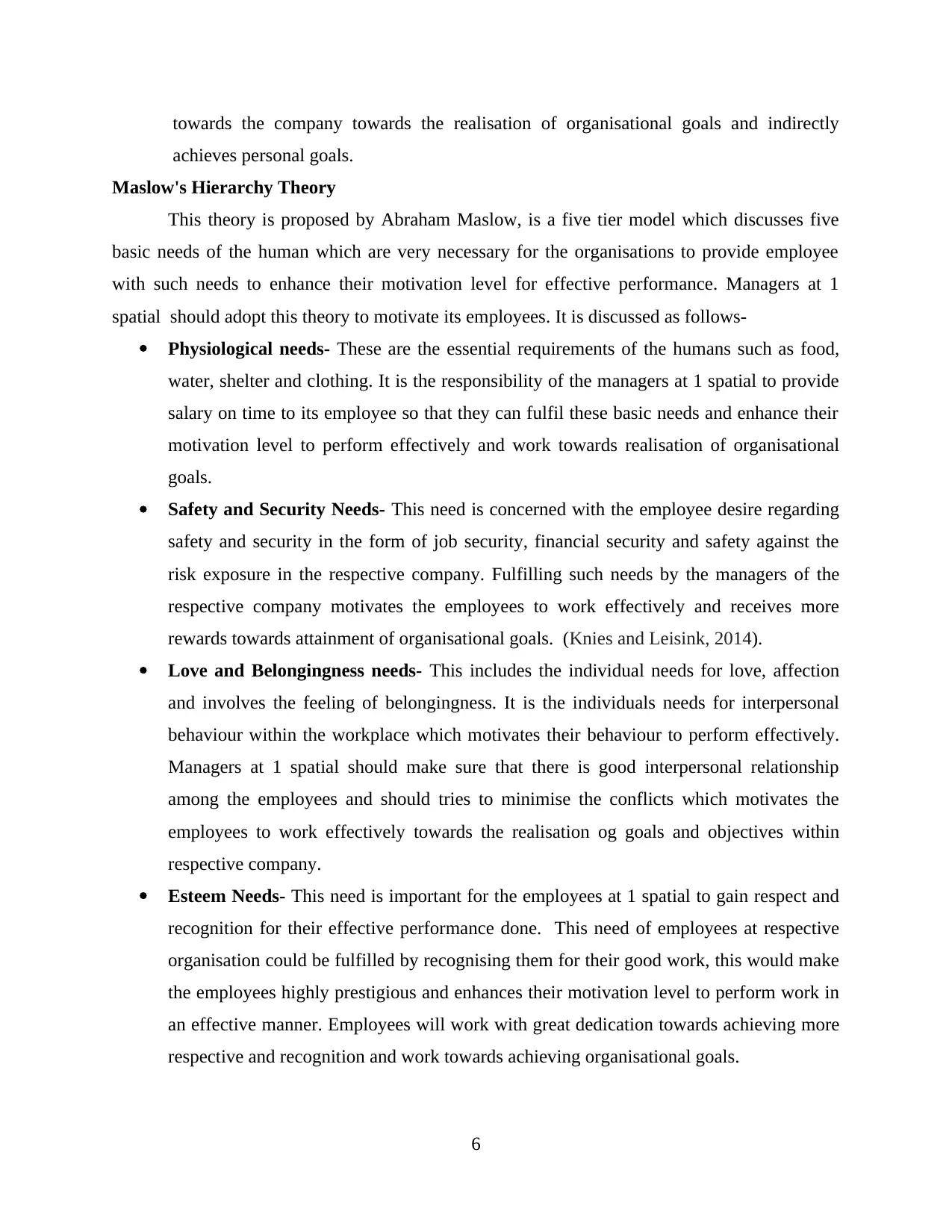
towards the company towards the realisation of organisational goals and indirectly
achieves personal goals.
Maslow's Hierarchy Theory
This theory is proposed by Abraham Maslow, is a five tier model which discusses five
basic needs of the human which are very necessary for the organisations to provide employee
with such needs to enhance their motivation level for effective performance. Managers at 1
spatial should adopt this theory to motivate its employees. It is discussed as follows-
Physiological needs- These are the essential requirements of the humans such as food,
water, shelter and clothing. It is the responsibility of the managers at 1 spatial to provide
salary on time to its employee so that they can fulfil these basic needs and enhance their
motivation level to perform effectively and work towards realisation of organisational
goals.
Safety and Security Needs- This need is concerned with the employee desire regarding
safety and security in the form of job security, financial security and safety against the
risk exposure in the respective company. Fulfilling such needs by the managers of the
respective company motivates the employees to work effectively and receives more
rewards towards attainment of organisational goals. (Knies and Leisink, 2014).
Love and Belongingness needs- This includes the individual needs for love, affection
and involves the feeling of belongingness. It is the individuals needs for interpersonal
behaviour within the workplace which motivates their behaviour to perform effectively.
Managers at 1 spatial should make sure that there is good interpersonal relationship
among the employees and should tries to minimise the conflicts which motivates the
employees to work effectively towards the realisation og goals and objectives within
respective company.
Esteem Needs- This need is important for the employees at 1 spatial to gain respect and
recognition for their effective performance done. This need of employees at respective
organisation could be fulfilled by recognising them for their good work, this would make
the employees highly prestigious and enhances their motivation level to perform work in
an effective manner. Employees will work with great dedication towards achieving more
respective and recognition and work towards achieving organisational goals.
6
achieves personal goals.
Maslow's Hierarchy Theory
This theory is proposed by Abraham Maslow, is a five tier model which discusses five
basic needs of the human which are very necessary for the organisations to provide employee
with such needs to enhance their motivation level for effective performance. Managers at 1
spatial should adopt this theory to motivate its employees. It is discussed as follows-
Physiological needs- These are the essential requirements of the humans such as food,
water, shelter and clothing. It is the responsibility of the managers at 1 spatial to provide
salary on time to its employee so that they can fulfil these basic needs and enhance their
motivation level to perform effectively and work towards realisation of organisational
goals.
Safety and Security Needs- This need is concerned with the employee desire regarding
safety and security in the form of job security, financial security and safety against the
risk exposure in the respective company. Fulfilling such needs by the managers of the
respective company motivates the employees to work effectively and receives more
rewards towards attainment of organisational goals. (Knies and Leisink, 2014).
Love and Belongingness needs- This includes the individual needs for love, affection
and involves the feeling of belongingness. It is the individuals needs for interpersonal
behaviour within the workplace which motivates their behaviour to perform effectively.
Managers at 1 spatial should make sure that there is good interpersonal relationship
among the employees and should tries to minimise the conflicts which motivates the
employees to work effectively towards the realisation og goals and objectives within
respective company.
Esteem Needs- This need is important for the employees at 1 spatial to gain respect and
recognition for their effective performance done. This need of employees at respective
organisation could be fulfilled by recognising them for their good work, this would make
the employees highly prestigious and enhances their motivation level to perform work in
an effective manner. Employees will work with great dedication towards achieving more
respective and recognition and work towards achieving organisational goals.
6
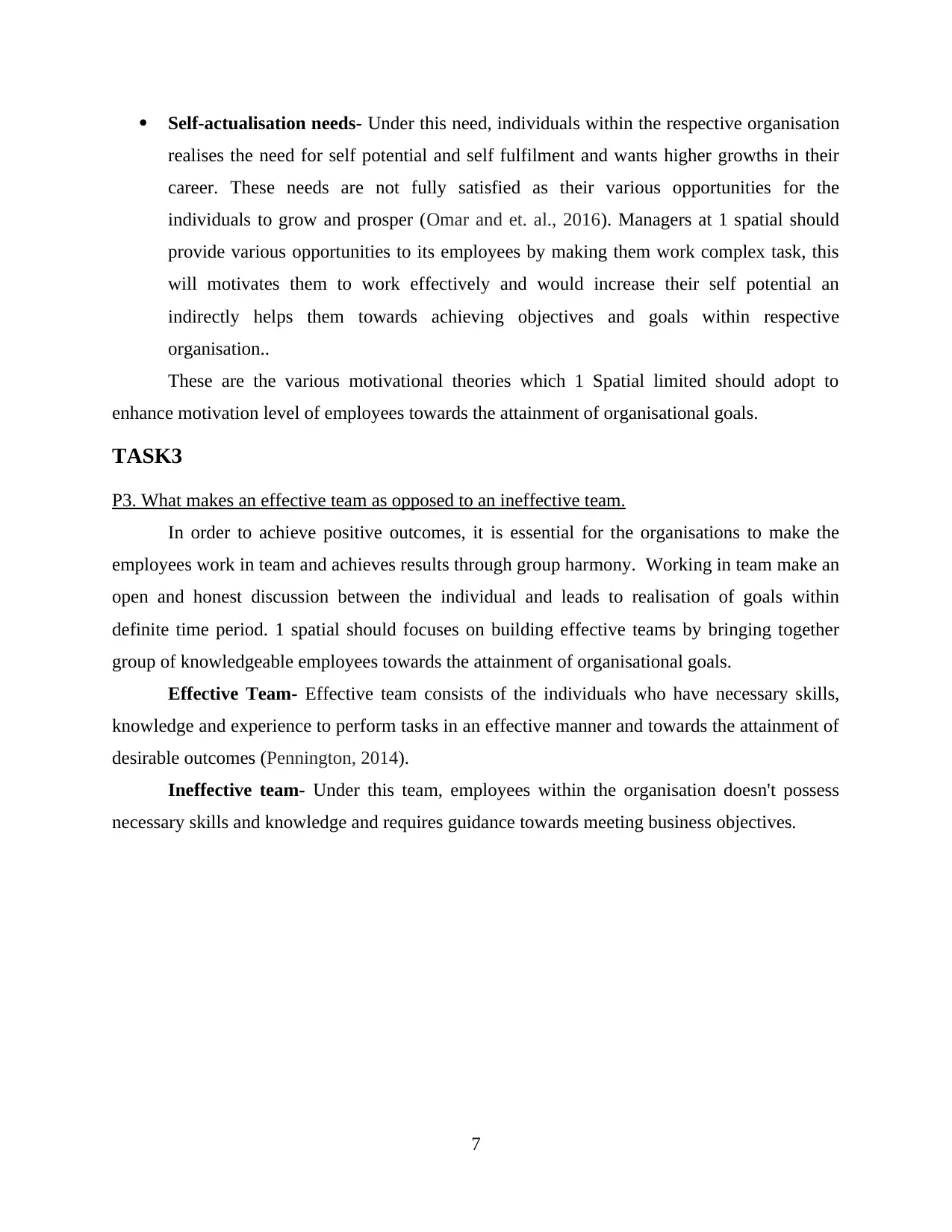
Self-actualisation needs- Under this need, individuals within the respective organisation
realises the need for self potential and self fulfilment and wants higher growths in their
career. These needs are not fully satisfied as their various opportunities for the
individuals to grow and prosper (Omar and et. al., 2016). Managers at 1 spatial should
provide various opportunities to its employees by making them work complex task, this
will motivates them to work effectively and would increase their self potential an
indirectly helps them towards achieving objectives and goals within respective
organisation..
These are the various motivational theories which 1 Spatial limited should adopt to
enhance motivation level of employees towards the attainment of organisational goals.
TASK3
P3. What makes an effective team as opposed to an ineffective team.
In order to achieve positive outcomes, it is essential for the organisations to make the
employees work in team and achieves results through group harmony. Working in team make an
open and honest discussion between the individual and leads to realisation of goals within
definite time period. 1 spatial should focuses on building effective teams by bringing together
group of knowledgeable employees towards the attainment of organisational goals.
Effective Team- Effective team consists of the individuals who have necessary skills,
knowledge and experience to perform tasks in an effective manner and towards the attainment of
desirable outcomes (Pennington, 2014).
Ineffective team- Under this team, employees within the organisation doesn't possess
necessary skills and knowledge and requires guidance towards meeting business objectives.
7
realises the need for self potential and self fulfilment and wants higher growths in their
career. These needs are not fully satisfied as their various opportunities for the
individuals to grow and prosper (Omar and et. al., 2016). Managers at 1 spatial should
provide various opportunities to its employees by making them work complex task, this
will motivates them to work effectively and would increase their self potential an
indirectly helps them towards achieving objectives and goals within respective
organisation..
These are the various motivational theories which 1 Spatial limited should adopt to
enhance motivation level of employees towards the attainment of organisational goals.
TASK3
P3. What makes an effective team as opposed to an ineffective team.
In order to achieve positive outcomes, it is essential for the organisations to make the
employees work in team and achieves results through group harmony. Working in team make an
open and honest discussion between the individual and leads to realisation of goals within
definite time period. 1 spatial should focuses on building effective teams by bringing together
group of knowledgeable employees towards the attainment of organisational goals.
Effective Team- Effective team consists of the individuals who have necessary skills,
knowledge and experience to perform tasks in an effective manner and towards the attainment of
desirable outcomes (Pennington, 2014).
Ineffective team- Under this team, employees within the organisation doesn't possess
necessary skills and knowledge and requires guidance towards meeting business objectives.
7
⊘ This is a preview!⊘
Do you want full access?
Subscribe today to unlock all pages.

Trusted by 1+ million students worldwide
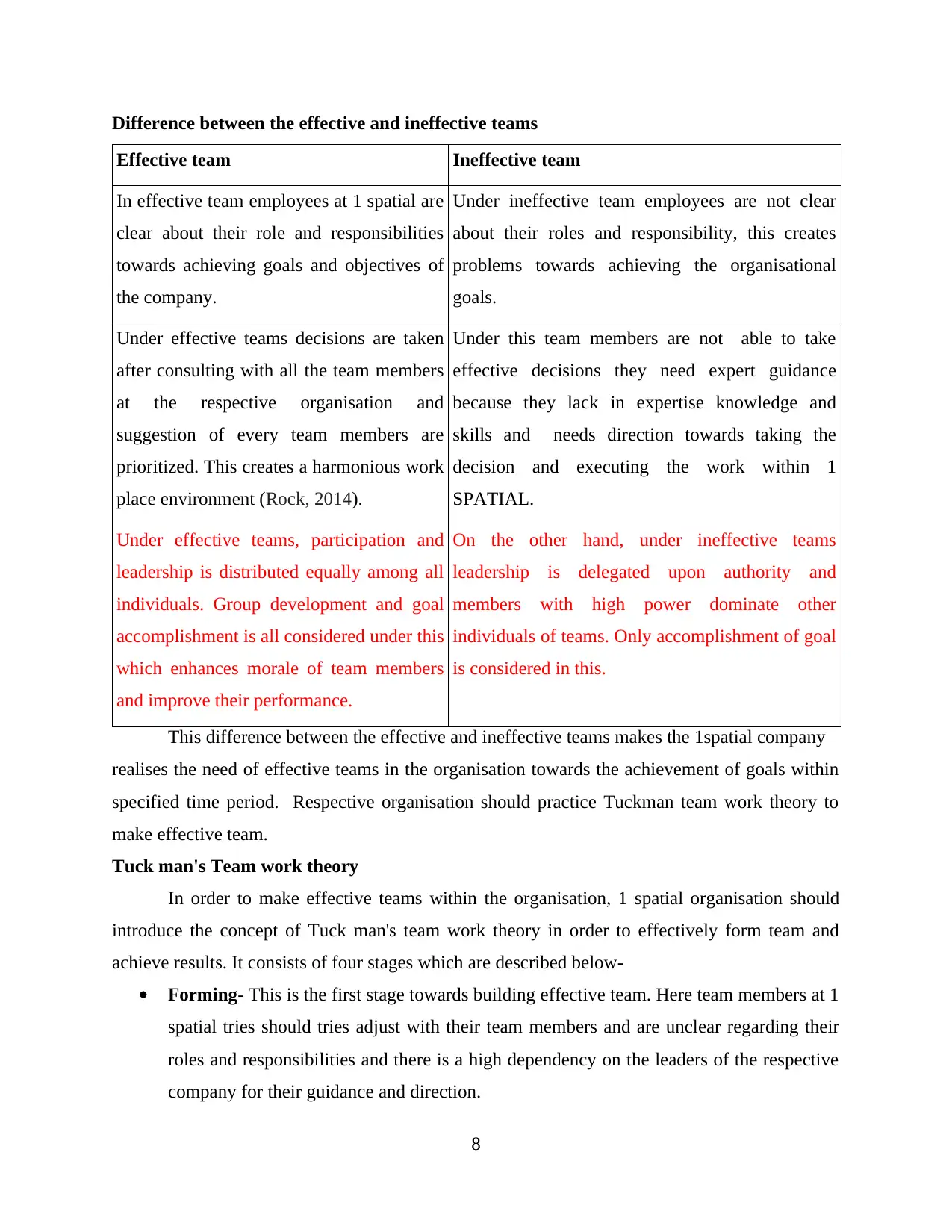
Difference between the effective and ineffective teams
Effective team Ineffective team
In effective team employees at 1 spatial are
clear about their role and responsibilities
towards achieving goals and objectives of
the company.
Under ineffective team employees are not clear
about their roles and responsibility, this creates
problems towards achieving the organisational
goals.
Under effective teams decisions are taken
after consulting with all the team members
at the respective organisation and
suggestion of every team members are
prioritized. This creates a harmonious work
place environment (Rock, 2014).
Under this team members are not able to take
effective decisions they need expert guidance
because they lack in expertise knowledge and
skills and needs direction towards taking the
decision and executing the work within 1
SPATIAL.
Under effective teams, participation and
leadership is distributed equally among all
individuals. Group development and goal
accomplishment is all considered under this
which enhances morale of team members
and improve their performance.
On the other hand, under ineffective teams
leadership is delegated upon authority and
members with high power dominate other
individuals of teams. Only accomplishment of goal
is considered in this.
This difference between the effective and ineffective teams makes the 1spatial company
realises the need of effective teams in the organisation towards the achievement of goals within
specified time period. Respective organisation should practice Tuckman team work theory to
make effective team.
Tuck man's Team work theory
In order to make effective teams within the organisation, 1 spatial organisation should
introduce the concept of Tuck man's team work theory in order to effectively form team and
achieve results. It consists of four stages which are described below-
Forming- This is the first stage towards building effective team. Here team members at 1
spatial tries should tries adjust with their team members and are unclear regarding their
roles and responsibilities and there is a high dependency on the leaders of the respective
company for their guidance and direction.
8
Effective team Ineffective team
In effective team employees at 1 spatial are
clear about their role and responsibilities
towards achieving goals and objectives of
the company.
Under ineffective team employees are not clear
about their roles and responsibility, this creates
problems towards achieving the organisational
goals.
Under effective teams decisions are taken
after consulting with all the team members
at the respective organisation and
suggestion of every team members are
prioritized. This creates a harmonious work
place environment (Rock, 2014).
Under this team members are not able to take
effective decisions they need expert guidance
because they lack in expertise knowledge and
skills and needs direction towards taking the
decision and executing the work within 1
SPATIAL.
Under effective teams, participation and
leadership is distributed equally among all
individuals. Group development and goal
accomplishment is all considered under this
which enhances morale of team members
and improve their performance.
On the other hand, under ineffective teams
leadership is delegated upon authority and
members with high power dominate other
individuals of teams. Only accomplishment of goal
is considered in this.
This difference between the effective and ineffective teams makes the 1spatial company
realises the need of effective teams in the organisation towards the achievement of goals within
specified time period. Respective organisation should practice Tuckman team work theory to
make effective team.
Tuck man's Team work theory
In order to make effective teams within the organisation, 1 spatial organisation should
introduce the concept of Tuck man's team work theory in order to effectively form team and
achieve results. It consists of four stages which are described below-
Forming- This is the first stage towards building effective team. Here team members at 1
spatial tries should tries adjust with their team members and are unclear regarding their
roles and responsibilities and there is a high dependency on the leaders of the respective
company for their guidance and direction.
8
Paraphrase This Document
Need a fresh take? Get an instant paraphrase of this document with our AI Paraphraser
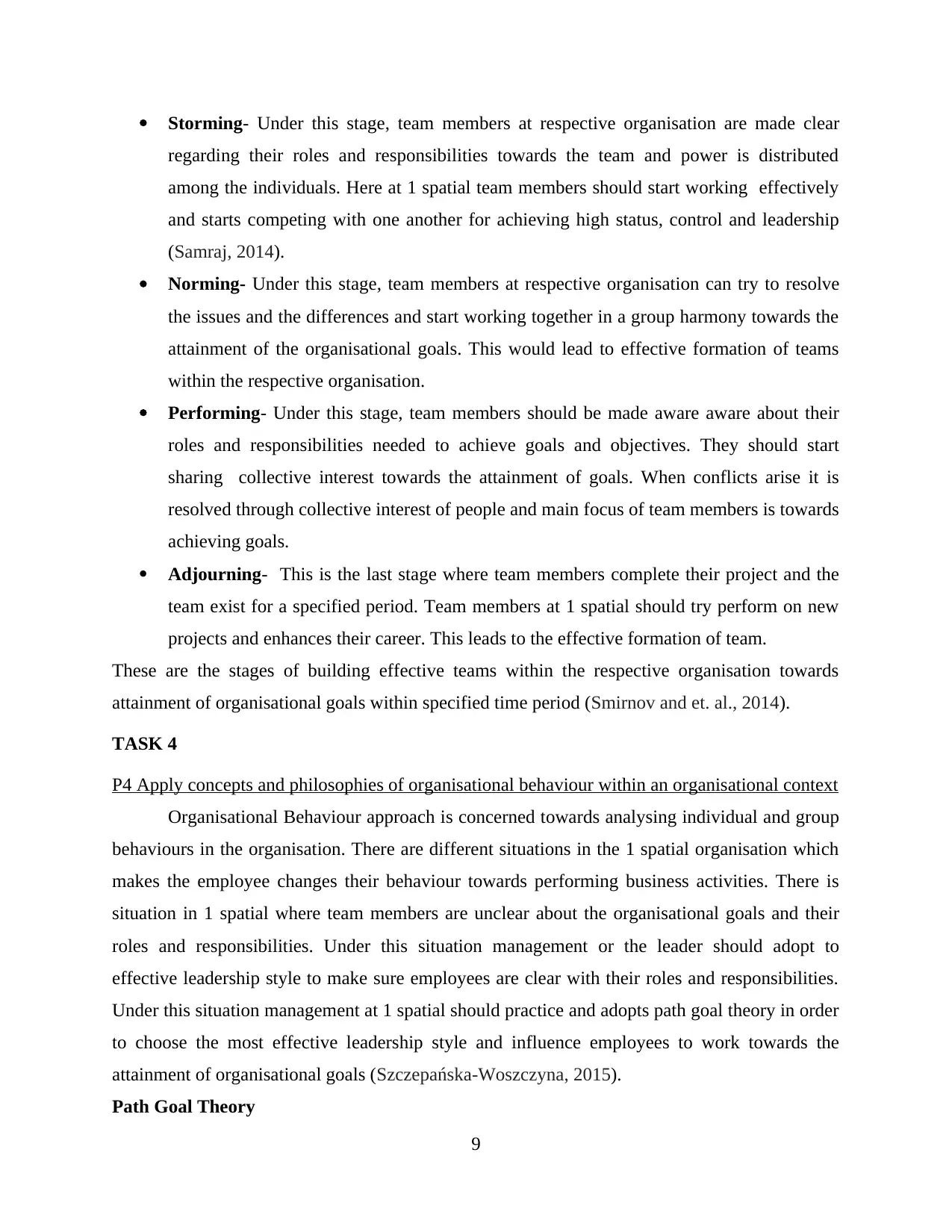
Storming- Under this stage, team members at respective organisation are made clear
regarding their roles and responsibilities towards the team and power is distributed
among the individuals. Here at 1 spatial team members should start working effectively
and starts competing with one another for achieving high status, control and leadership
(Samraj, 2014).
Norming- Under this stage, team members at respective organisation can try to resolve
the issues and the differences and start working together in a group harmony towards the
attainment of the organisational goals. This would lead to effective formation of teams
within the respective organisation.
Performing- Under this stage, team members should be made aware aware about their
roles and responsibilities needed to achieve goals and objectives. They should start
sharing collective interest towards the attainment of goals. When conflicts arise it is
resolved through collective interest of people and main focus of team members is towards
achieving goals.
Adjourning- This is the last stage where team members complete their project and the
team exist for a specified period. Team members at 1 spatial should try perform on new
projects and enhances their career. This leads to the effective formation of team.
These are the stages of building effective teams within the respective organisation towards
attainment of organisational goals within specified time period (Smirnov and et. al., 2014).
TASK 4
P4 Apply concepts and philosophies of organisational behaviour within an organisational context
Organisational Behaviour approach is concerned towards analysing individual and group
behaviours in the organisation. There are different situations in the 1 spatial organisation which
makes the employee changes their behaviour towards performing business activities. There is
situation in 1 spatial where team members are unclear about the organisational goals and their
roles and responsibilities. Under this situation management or the leader should adopt to
effective leadership style to make sure employees are clear with their roles and responsibilities.
Under this situation management at 1 spatial should practice and adopts path goal theory in order
to choose the most effective leadership style and influence employees to work towards the
attainment of organisational goals (Szczepańska-Woszczyna, 2015).
Path Goal Theory
9
regarding their roles and responsibilities towards the team and power is distributed
among the individuals. Here at 1 spatial team members should start working effectively
and starts competing with one another for achieving high status, control and leadership
(Samraj, 2014).
Norming- Under this stage, team members at respective organisation can try to resolve
the issues and the differences and start working together in a group harmony towards the
attainment of the organisational goals. This would lead to effective formation of teams
within the respective organisation.
Performing- Under this stage, team members should be made aware aware about their
roles and responsibilities needed to achieve goals and objectives. They should start
sharing collective interest towards the attainment of goals. When conflicts arise it is
resolved through collective interest of people and main focus of team members is towards
achieving goals.
Adjourning- This is the last stage where team members complete their project and the
team exist for a specified period. Team members at 1 spatial should try perform on new
projects and enhances their career. This leads to the effective formation of team.
These are the stages of building effective teams within the respective organisation towards
attainment of organisational goals within specified time period (Smirnov and et. al., 2014).
TASK 4
P4 Apply concepts and philosophies of organisational behaviour within an organisational context
Organisational Behaviour approach is concerned towards analysing individual and group
behaviours in the organisation. There are different situations in the 1 spatial organisation which
makes the employee changes their behaviour towards performing business activities. There is
situation in 1 spatial where team members are unclear about the organisational goals and their
roles and responsibilities. Under this situation management or the leader should adopt to
effective leadership style to make sure employees are clear with their roles and responsibilities.
Under this situation management at 1 spatial should practice and adopts path goal theory in order
to choose the most effective leadership style and influence employees to work towards the
attainment of organisational goals (Szczepańska-Woszczyna, 2015).
Path Goal Theory
9
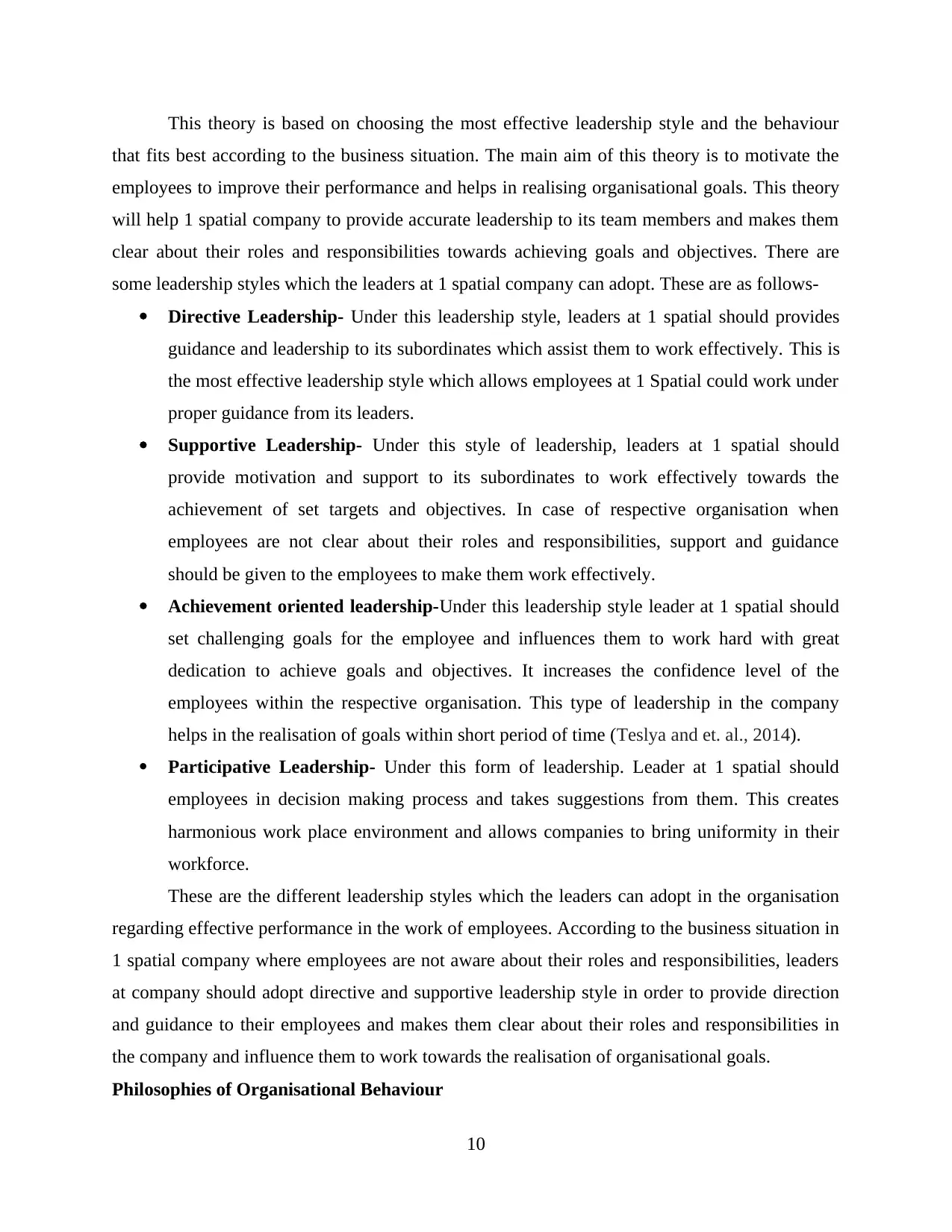
This theory is based on choosing the most effective leadership style and the behaviour
that fits best according to the business situation. The main aim of this theory is to motivate the
employees to improve their performance and helps in realising organisational goals. This theory
will help 1 spatial company to provide accurate leadership to its team members and makes them
clear about their roles and responsibilities towards achieving goals and objectives. There are
some leadership styles which the leaders at 1 spatial company can adopt. These are as follows-
Directive Leadership- Under this leadership style, leaders at 1 spatial should provides
guidance and leadership to its subordinates which assist them to work effectively. This is
the most effective leadership style which allows employees at 1 Spatial could work under
proper guidance from its leaders.
Supportive Leadership- Under this style of leadership, leaders at 1 spatial should
provide motivation and support to its subordinates to work effectively towards the
achievement of set targets and objectives. In case of respective organisation when
employees are not clear about their roles and responsibilities, support and guidance
should be given to the employees to make them work effectively.
Achievement oriented leadership-Under this leadership style leader at 1 spatial should
set challenging goals for the employee and influences them to work hard with great
dedication to achieve goals and objectives. It increases the confidence level of the
employees within the respective organisation. This type of leadership in the company
helps in the realisation of goals within short period of time (Teslya and et. al., 2014).
Participative Leadership- Under this form of leadership. Leader at 1 spatial should
employees in decision making process and takes suggestions from them. This creates
harmonious work place environment and allows companies to bring uniformity in their
workforce.
These are the different leadership styles which the leaders can adopt in the organisation
regarding effective performance in the work of employees. According to the business situation in
1 spatial company where employees are not aware about their roles and responsibilities, leaders
at company should adopt directive and supportive leadership style in order to provide direction
and guidance to their employees and makes them clear about their roles and responsibilities in
the company and influence them to work towards the realisation of organisational goals.
Philosophies of Organisational Behaviour
10
that fits best according to the business situation. The main aim of this theory is to motivate the
employees to improve their performance and helps in realising organisational goals. This theory
will help 1 spatial company to provide accurate leadership to its team members and makes them
clear about their roles and responsibilities towards achieving goals and objectives. There are
some leadership styles which the leaders at 1 spatial company can adopt. These are as follows-
Directive Leadership- Under this leadership style, leaders at 1 spatial should provides
guidance and leadership to its subordinates which assist them to work effectively. This is
the most effective leadership style which allows employees at 1 Spatial could work under
proper guidance from its leaders.
Supportive Leadership- Under this style of leadership, leaders at 1 spatial should
provide motivation and support to its subordinates to work effectively towards the
achievement of set targets and objectives. In case of respective organisation when
employees are not clear about their roles and responsibilities, support and guidance
should be given to the employees to make them work effectively.
Achievement oriented leadership-Under this leadership style leader at 1 spatial should
set challenging goals for the employee and influences them to work hard with great
dedication to achieve goals and objectives. It increases the confidence level of the
employees within the respective organisation. This type of leadership in the company
helps in the realisation of goals within short period of time (Teslya and et. al., 2014).
Participative Leadership- Under this form of leadership. Leader at 1 spatial should
employees in decision making process and takes suggestions from them. This creates
harmonious work place environment and allows companies to bring uniformity in their
workforce.
These are the different leadership styles which the leaders can adopt in the organisation
regarding effective performance in the work of employees. According to the business situation in
1 spatial company where employees are not aware about their roles and responsibilities, leaders
at company should adopt directive and supportive leadership style in order to provide direction
and guidance to their employees and makes them clear about their roles and responsibilities in
the company and influence them to work towards the realisation of organisational goals.
Philosophies of Organisational Behaviour
10
⊘ This is a preview!⊘
Do you want full access?
Subscribe today to unlock all pages.

Trusted by 1+ million students worldwide
1 out of 15
Related Documents
Your All-in-One AI-Powered Toolkit for Academic Success.
+13062052269
info@desklib.com
Available 24*7 on WhatsApp / Email
![[object Object]](/_next/static/media/star-bottom.7253800d.svg)
Unlock your academic potential
Copyright © 2020–2025 A2Z Services. All Rights Reserved. Developed and managed by ZUCOL.





